How To Train Your Goats
Having goats that are trained is not only possible it just might be easier than you think. Learn how to train your goats to behave on the milk stand and to come when called so everyone can stay safe on your homestead.
Training your goats to behave, as well as teaching them a few simple commands, is a great tool to have for learning how to raise dairy goats that listen and stay safe.
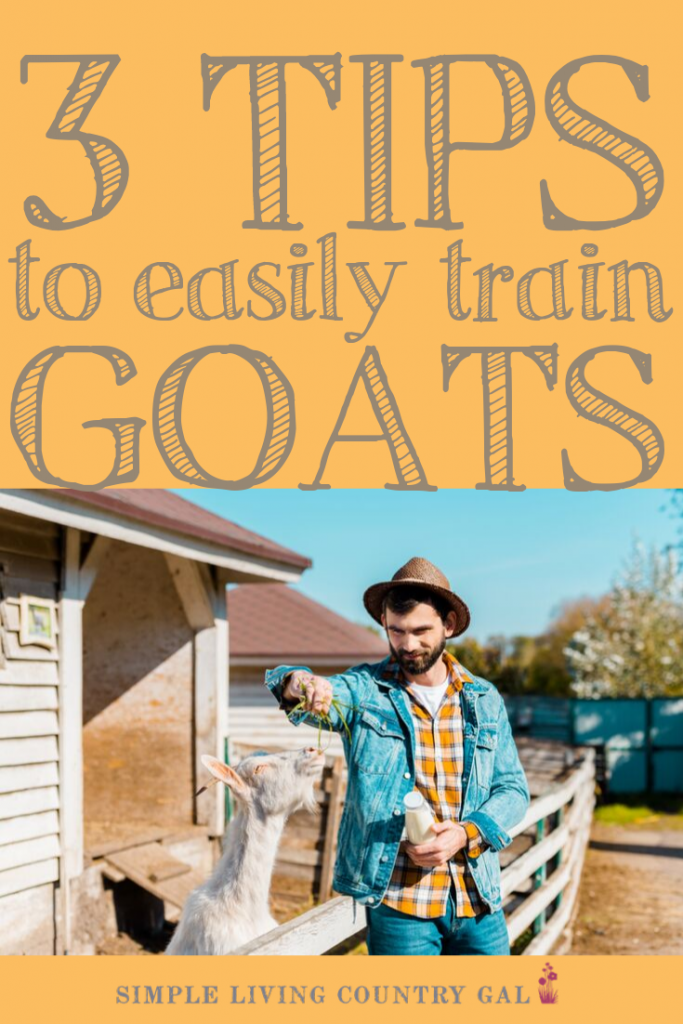
I learned very early on that goats are comical, smart, loving, determined, and yes, very stubborn.
When my first two goats joined our little homestead, I was as green as could be. I had absolutely no clue where to start, what they needed, and how to keep them safe and healthy. As usual, winging it was my first course of action and I pretty much stumbled along learning as I did.
One of the first things I learned was that goats have a mind of their own and, if not trained properly, will do whatever they please. That meant I needed to teach my goats to listen to me and understand that I was in charge. If I called them to come in from the pasture or expected them to behave on a milk stand, it was in their best interest to listen.
Let me just say that, in theory, this made perfect sense, but when I put it into action, I learned a valuable thing. Some goat breeds are easy to train, and others…well, not so much.
I remember that first day I was going to milk my goat, Oleo. Hubby made me a beautiful milk stand and I must have watched a zillion YouTube videos on how to milk goats and sheep. I even went to a farm and had a sweet Amish farmhand give me a milking lesson.
I was fully confident and ready to fill my shiny new pail with some tasty milk.
I confidently headed out with my milking supplies in hand and a spring in my step. Once in the barn, I set everything up and went to get my doe. I took her by the collar and led her to the milk stand. She came willingly enough, but once there, she took one look at that stand and took off the other way!
After chasing her down, I tried it again only to have the same result.
What the hay! (yes, this is what I say now) This wasn’t what I expected at all. I led her over for a third time, thoroughly sweating by now, and was forced to pick her up and put her on the stand.
Yes, I picked up a 120-pound goat!
Once I had her on the stand and locked in, the fun didn’t stop there. She then proceeded to do a very impressive Irish tap dance all over the place spilling milk and making a rather large mess in the process.
I now know where the saying “Don’t cry over spilled milk” came from. I left that morning dejected, with only a cup of milk to show for all my efforts. And now that I think of it, I believe I WAS crying.
That day, I learned a very important lesson. Animals have no idea what you want them to do, and if it is new, they will be very wary and often too scared to listen without caution. To make things easier for everyone, I needed to figure out how to train my goats to listen and work with me—not against me.
Get my tips on how to train rowdy goats to eat calmly in my Tethered Feeding Goats post.
How to Train Your Goats
Goat Training Disclaimer: If you have an aggressive goat, a wild goat (meaning not people-friendly), or just an all-around mean goat, this system may not work for you and your situation. Sometimes, hard decisions need to be made. If you have tried everything and you find your goat is still uncontrollable, you may need to make some hard decisions and look for a new home. I have had to do this myself, and even though it is hard, I know we are both better off.
Owning goats, especially a family goat, for a homestead or backyard farm should be pleasant and rewarding. Remember, not all animals fit all families. Know when it’s time to find a new home for your animal and try again until you get a good fit.
Grab the FREE Goat Training Guide Below!
Step #1. Find What They Love
If you want to get a goat to do what you want, you need to train your goats with a heavy dose of patience, and (this is VERY important) F O O D. Goats are very food motivated, meaning they will do just about anything if food is involved. Especially their favorite foods.
If you are not sure what your goats like, let’s go over a few things my goats love to nibble on and what I have used to help to train them to come and behave.
Favorite goat treats:
- Banana peels – YES! Goats love bananas, especially the peals. Keep a few in a Ziploc baggie to use whenever you are doing a training session.
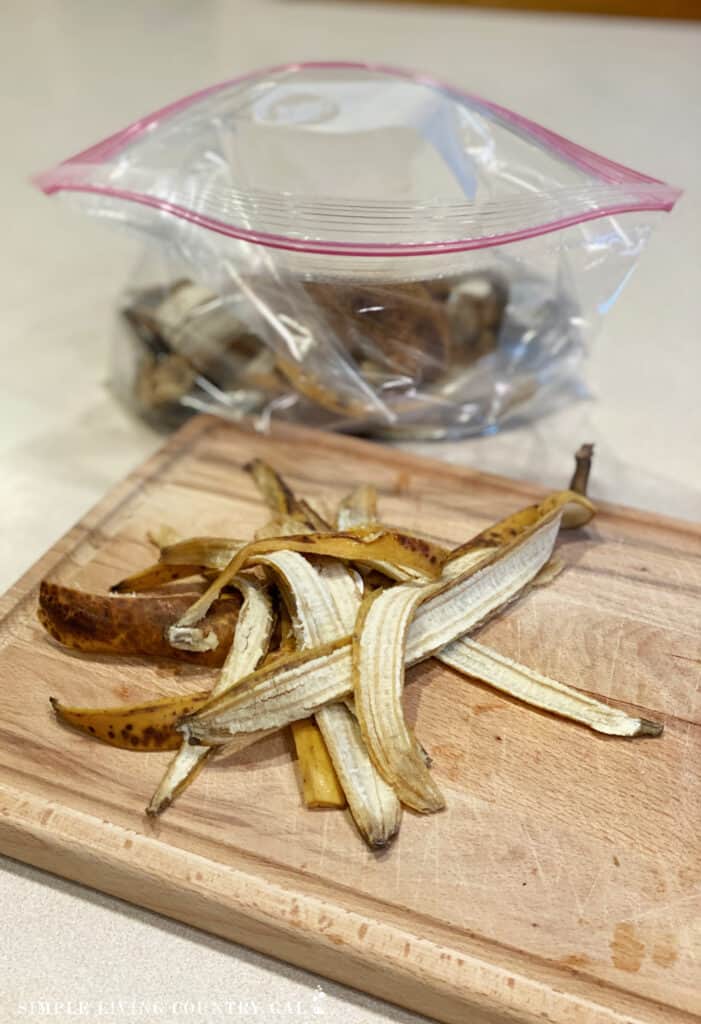
- Apples – Be sure to only give them in small bites so your goats do not choke.
- Carrots – Again, use small bites until they are used to them.
- Garlic – Not only a great treat but a natural wormer!
- 2nd cut hay – A great motivator to keep goats still in a milk stand
- Animal crackers – More of a junk food but will work in a pinch.
Manna Pro Goat Mineral Supplement – Made with Vitamins & Minerals to Support Growth & Development – Contains Ammonium Chloride – Microbial Blend for Digestion – 8 lbs


Step#2. Repetition
When it comes to training your goats, or any animal, repetition is key. Lead your goats where you want them to go and reward them with their feed ration of grain or with a couple of treats. You only need to do this a few times, and they will quickly learn where to go, even without being led!
SLCG PRO TIP: Always lead a goat, do NOT pull. A goat will quickly put on the brakes if forced to go anywhere. If leading does not work, you can try gently pushing from behind instead. You will get much better results with a push rather than a pull.
I have come a long way since that first milking fiasco. Now, before I begin milking a new goat I will do test runs a week or two in advance to acclimate her and myself to our new routine. If you have a trust/bond already established, this will not take very long. Just remember it is important to be patient and flexible.
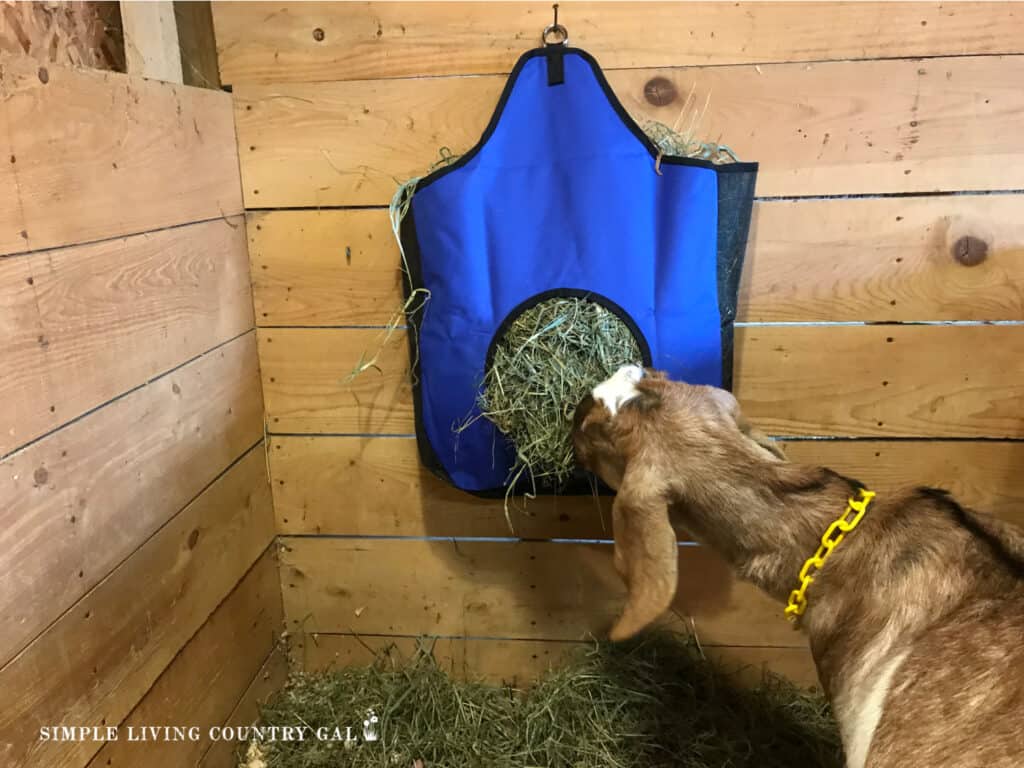
Step #3. Be flexible
If something doesn’t work or “flow”, as well as you would like, you may need to try a different approach or a different setup altogether.
Goats are easily spooked, and anything out of the ordinary will cause them to stand back. That is why having a routine is so important. The more they do something daily the more they will become comfortable and willing to go where you want them to.
Training Tips
Let me jump in here and share a few training tips I learned over the years.
Training Tip #1. Never use force
When you are training, never force your goats to do anything. If you force them, you may damage the trust bond you are trying hard to establish, and you will also most likely not get the results you are hoping for.
If you give your goat guidance and patience, she will usually do what you want.
Training Tip #2. Never loose patience
Never lose patience with a goat you are training or a goat you are trying to get on the milk stand. If you have a goat that is simply misbehaving. Stop. Take a deep breath and try again. If you still have problems, remove the goat from the stand and try again when you have both calmed down.
Training Tip #3. Never hit your goats
It goes without saying, you should never hit your goats. I know farmers that insist you need to whack a goat to get them to listen but I know this is not the case. The more patient and calm I am the more my animals will mirror that image.
Step #4. How to Train Your Goat to Use a Milk Stand
As I mentioned earlier, if you want to succeed when you train your goats, you need to have plenty of patience.
Fast-forward to two years later into my goat-raising journey. In my now established herd, I had a doe that was terrified of anything new. She was due to deliver for the first time in a month and I was planning on milking her at the 2-week mark after kidding. I knew that with her skittish tendencies I was not going to attempt to train her to jump onto the milk stand pregnant as this might risk injury to her or her unborn kids.
I instead chose to wait until after she kidded.
Most of my goats can be trained in a few days, Wren, I knew, would take much longer. Knowing this going in helped to keep me calm and gentle while we worked on her training.
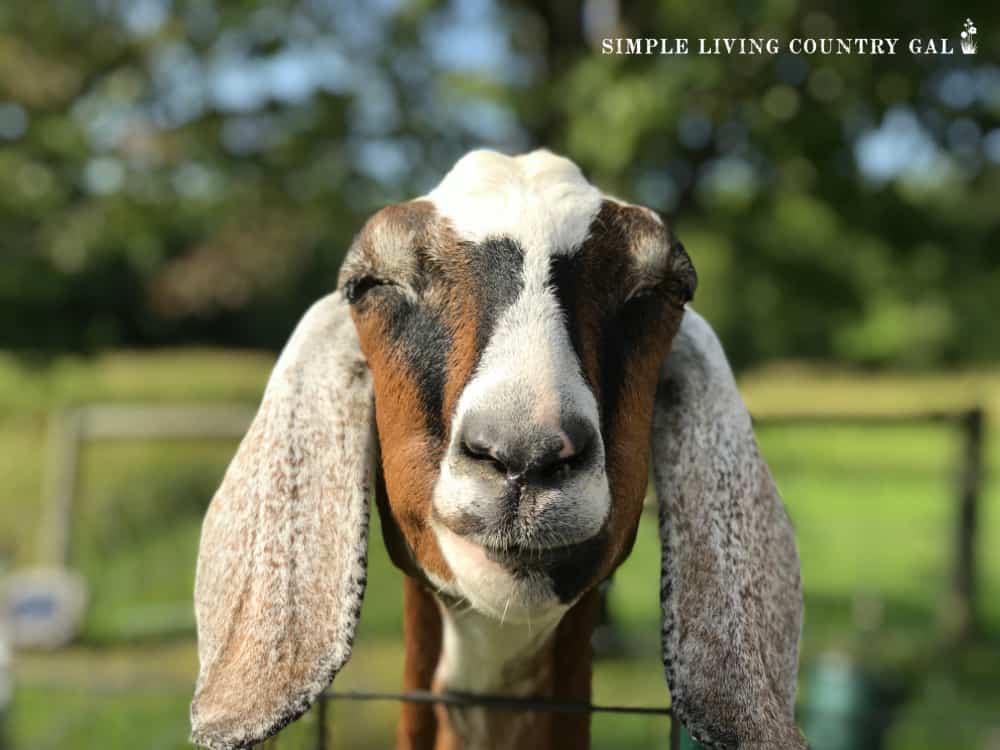
One of the first things I did was that every time I went to the barn, I would touch her udder. Wren hated to have her udder touched, but I needed her to get used to me touching it so I could milk her. At first, she would kick and run, but eventually, she stayed still and let me touch and actually massage her udder.
After she kidded a beautiful doeling, I gave her a few days to be with her kid before training began. This gave her time to adjust to motherhood and bond with her baby.
The first step was to get her used to the stand, I took her over a few times a day and let her see it. I put her feed bowl on the stand so she would begin to associate the stand with food. After just a couple of days, I was able to get her to jump up on the stand and lock her in. I continued to feed her there every feeding for several days. Since I was not yet milking her I would instead use this time for much-needed maintenance on her coat and hooves.
Hubby made this milk stand for me, and I absolutely love it. You can see how to build one here for free or you can purchase a metal milking stand from Amazon.
Even after all of this, Wren would still kick every so often, so I finally began using goat hobbles like these , and I must say they work amazingly well.
If you are new to goat hobbles they are basically a canvas strap that loops around the doe’s legs ABOVE the knee and are held together with velcro. This strap safely holds the goat’s legs together so she cannot easily kick or buck, although she may still be able to jump. I have used hobbles successfully for years and they do not harm the goat but instead keep us both safe and free from injury.
READ: HOW TO MILK A DIFFICULT GOAT USING USE HOBBLES
I have been milking Wren for 3 seasons now and I am happy to report that she has become my milking rock star. She is a lady in the stand, lets me do all I need to do without having to rush and will stand patiently for any additional work.
Here is a video of what you can do when you train your goats. It is a little chaotic but you get the picture. You can literally teach your goats to do anything, even a feeding regimen that is more like a do-si-do at a square dance!
Step #5. How to Train Your Goats to Come When Called
This might be the one trick you would like your goats to learn. To come whenever you call them. This can be incredibly helpful if you have a large pasture and you need to get them into the barn quickly.
- To train your goats you first need to choose a “call”. A word and voice that is unique to what it is you want them to do.
- Next, you will want to begin using this call every single time you feed them. Whether they are in the barn with you or not.
- Each time you give them hay or grain simply say the word in the voice you chose. This will teach them that whenever they hear that word/sound food is on its way!
- Remember, goats are very food-oriented and will quickly learn what they need to do in order to eat.
Step #6. Train Your Goats to Eat Tethered
I am a huge proponent of supporting my animal’s health with the correct food, herbs, and supplements. This means that each of my animals may have a different diet than the others. Since this is the case with our goats, I decided to train them to eat while they were tethered to a post in our barn. This allows me to custom tailor feed for each goat and ensures they are getting all the support they need to be healthy.
Training my goats to eat this way took some time, but the framework was still the same.
- Repetition
- Feed
- Patience
How I did it was to focus on one goat at a time. I would put out the feed next to that goat’s station, then call the goat by name allowing only that one goat to come out to the feeding area in our barn. Usually, they went right to the food, and once there I was able to attach their tether. I would then put out the next bowl and call in the next goat. I continued doing this in the same order for a few days and was surprised to see how quickly they took to it.
If tethered feeding is something you want to try on your farm, you can read how I did it HERE.
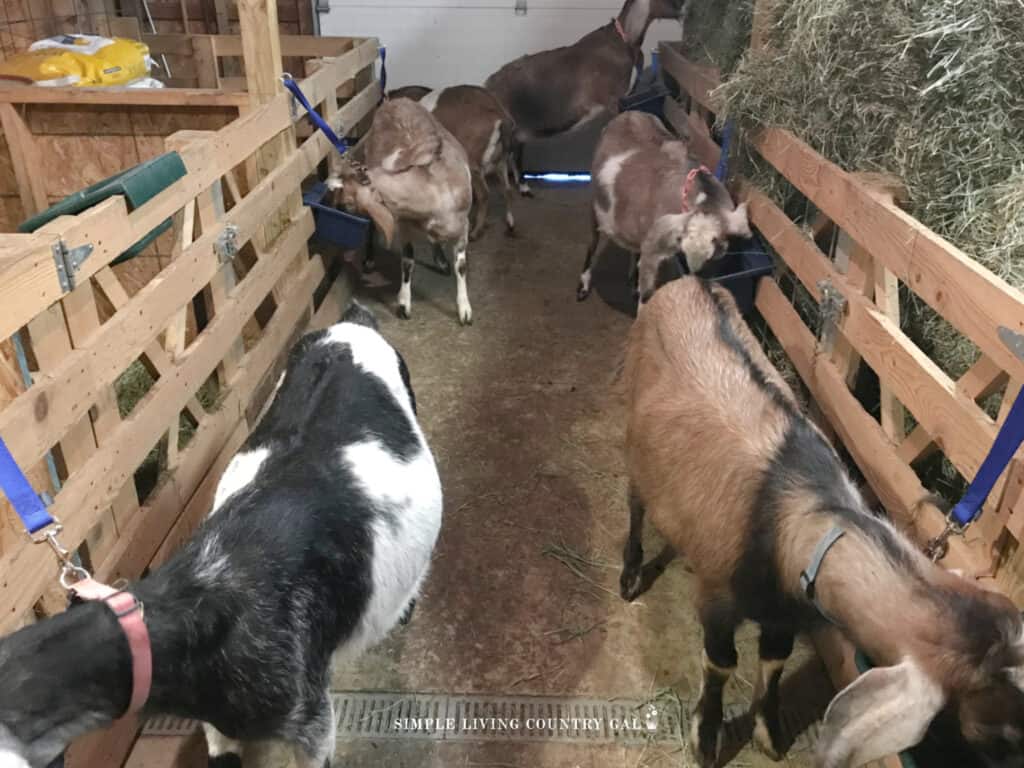
To safely raise animals it is good to have them trained to do what you want when you want it. Does it work all the time? No. But it does work enough that investing time in training your own goats is time well spent.
It is so important to remember with goats that patience (and food) is the key to a trusting and loving relationship. Follow these tips and you too can easily train your goats.


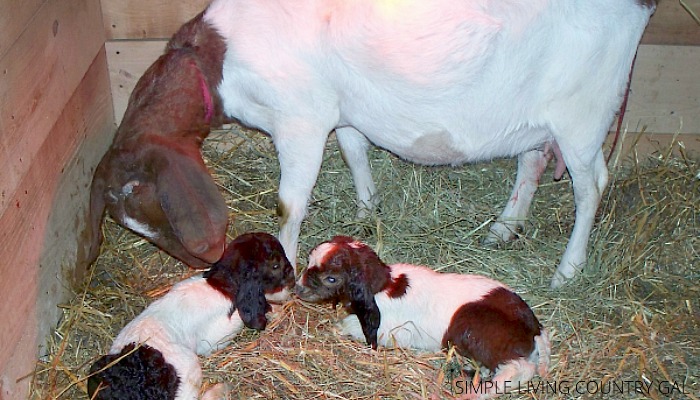
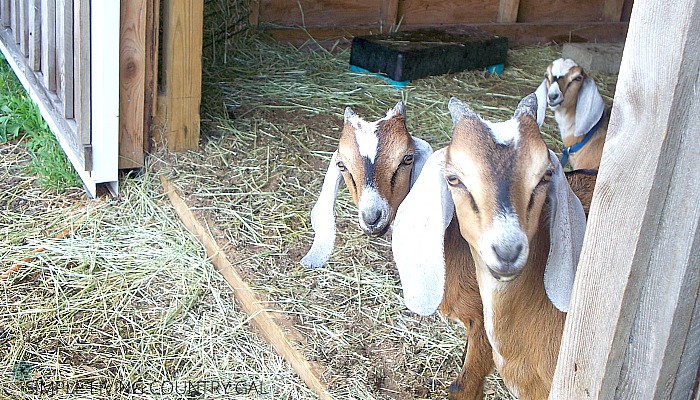




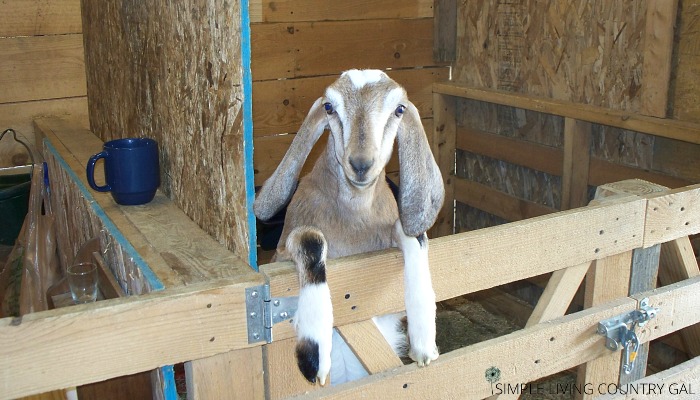
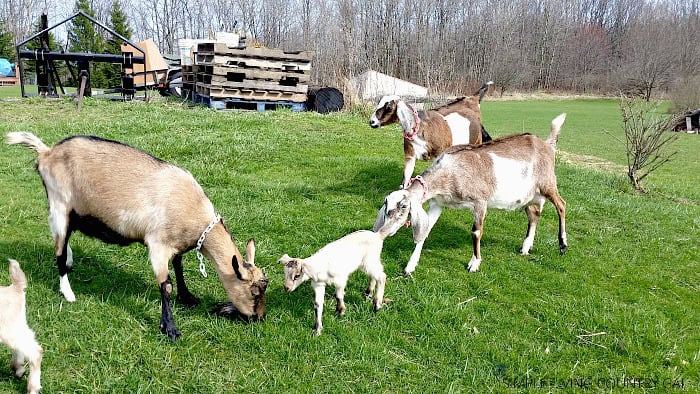
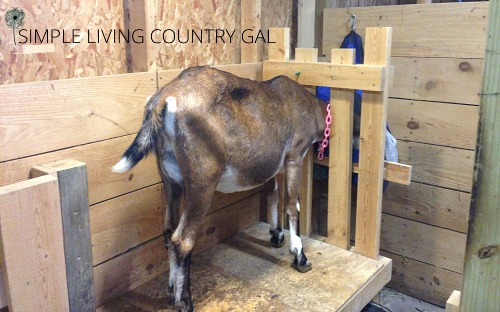
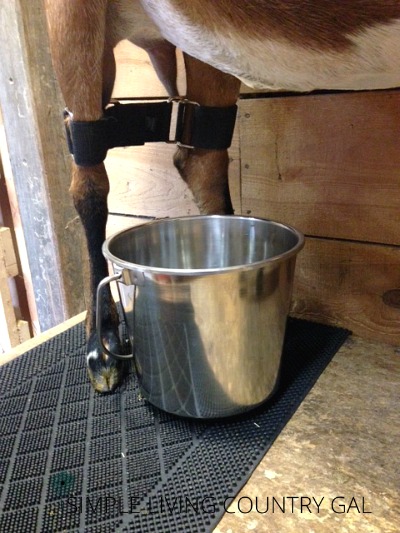
Time and patience, even for goats. Thanks for the look into their true individual selves.
It’s easier to train your babies to the milk stand.. so when it’s time to milk they know where to go!
Yes, I agree! That is why we do all maintenance work on milk stands for our kids. It really helps them to know that the milk stand is nothing to be fearful of!
Great tip,
Tracy Lynn
Love your videos. We need to build a new goat barn and I like yours. Could you send me a picture of the inside with stalls. Just trying to get ideas. Thanks
Hi, Dot!
Yes, I absolutely will. We were going to build a barn when I first got started in goats but instead converted our storage shed into a small goat barn and it evolved from there.
Tracy Lynn
Hi Tracy Lynn,
Is there a way you could send me the set up too? I was just admiring your stalls and saw this comment! 😀 I appreciate it so much! -Lauren
Hi, Lauren!
I am working on a post on this very thing, so if you are on my Homesteading Newsletter you will get an email with the link as soon as it’s done!!
Thanks for stopping by,
Tracy Lynn
I watched your feeding video. Can you give me tips on how you accomplished this? We have a weathered male Nubian who is aggressive towards the other goats that are all dwarf breeds. I’d like for feeding time to be smooth like yours.
Hi, Alison,
An aggressive goat is a bit of a different situation. I have two aggressive goats and the easiest way for me is to feed them separately. I put then in an area by themselves so they can eat and the other goats can eat without issue. If you have an area to put them that may be your best best. Another idea is to tether them to a tree or wood beam to feed them. The I train my goats is with food. I do not use treats. If they know that grain is at the end destination they usually learn quite quickly to do what is asked of them. If your buck realizes that food is at the end destination he should go willingly. It may take several attempts but in my experience, this usually eventually works.
I hope this helps a bit!
Tracy Lynn
I have no audio on your video. Have others had this problem? Thanks!
Oh, goodness, no I have not been told this before Marcia! can you try it in a different browser and let me know if it still happens?
Thanks
Tracy Lynn
I’m also planning a new barn and would love to incorporate some ideas from your barn. Could you please add me to your emails so I can get the link to your information.
Thank you.
Hi, Sandra!
I added you to my list and sent you a copy of my free homestead planner pack!
Welcome!
Tracy Lynn
I’ll be joining after this comment so I may find the answer but my predicament is two neutered males -Boer – nubian mix- and they are big! About 5 yrs old now and will nearly run me over when they hear the can open and I come down with the food. I’d like to hear ways to start an easier, more orderly feeding tme. I’ve recently added 3 Nigerian dwarfs -2 girls and one boy who are better at sharing but also make a mad dash for the food so I’m thinking there may be a few solution options that might work on all of them. Thanks, Joe
Hi, Joe!
Your comment made me smile since I am getting ready to create a new feed routine for my overly zealous herd of goats. They are getting a bit too rowdy when I go into the main stall to feed and before babies start coming I know I need to fix this and quick. I am going to lead feed my goats and I hope this will fix the issue on my end and may just be a fix for you as well.
Lead feeding is when you connect a goat to a lead that is attached to the wall. This way all they can do is eat their own food and no one else’s. The trick is teaching the goats to approach their lead and eat with manners. Ha, easier said than done right?! I plan to take each goat one at a time and bring them out to their lead and feed them at the lead. They should learn pretty quickly what is expected of them and this I hope will solve the problem. I hope to do a post/video of this new system and put it all up on the blog when it’s done. So watch out for that!
As far as your bigger goats, my large buck can get pretty excited when I come in with the food so I learned that he gets his hay first. This usually calms them down a bit since they are beginning to fill that belly up. I am not sure if you feed hay or let them graze all day but another trick is banana peels. My goats love them and I put a couple in a bowl that is put in their pen away from the gate. This will distract them just enough for me to get the feed in without issue. I usually have my farm help do this tip since my big guy now is pretty well trained.
Hope this helps!
Tracy Lynn
Hi! We have a good sized cattle ranch. We’re extremely familiar with bummer calves. Well, my papa gave me two two week old baby goats about six weeks ago. Both does. I am at a complete loss with these babies. I’ve been raising them in the house. They’re two mos. old now. I’ve been feeding them high quality goat milk replacer. They have a big 4’x8’ pen I made for them. It’s got wood chips on the bottom and grass hay on top of that (the floor is plywood w/black plastic stapled underneath). There’s always Goat Balancer Comprehensive Supplement (pellets), goat treats (some treat that tastes like anise), a goat mineral mix and high quality alfalfa. Oh, and fresh water is always available.
I have no idea if 9m feeding them right. They get three bottles a day (20 oz. each feeding). Between them they’re going through a gallon of milk replacer a day. The directions on the bag only went to 5 pounds. One is 22 lbs. The other is 20 lbs. When outside they nibble on greenery and love dead oak leaves. They just don’t seem too interested in anything but their bottle at feeding time. Am I doing this right? Should they be eating more and drinking less? They only like it outside if one of their people are with them.
I’ve learned that I can’t potty train them. Much to my dismay. I’ve got two eight month Bloodhounds. I figured if I could potty train them a baby goat should be no problem! Holy cow! How naive was I? I’m sure I’ve done everything wrong for these babies so far. Who has goats in the house, right?
If you could, I’d sure like to know what I should be doing. I couldn’t find a book, “What to Expect the First Year” for baby goats. I had one for my daughters! Well, heck, they’d probably tell you I didn’t do that by the book anyway! I am totally in love with these little creatures. Way funnier than a baby calf! I have a three year old cow that will go anywhere I want her to as long as she’s sucking on my hand!
Thank you and I look forward to hearing back from you. -Jennifer
Hi, Jennifer!
Oh boy, if I could house train a goat then I would probably have more than just a few in the house with me as well! But no, those stinkers need to be outside. (much to Hub’s relief!)
As far as bottle feeding you will want to cut them back to 2 times a day when they are 8 weeks then when they are 9 weeks cut them back to 1 bottle a day, gradually cutting back the amount of milk given each day. This should only take 1 week to be completely weaned. Note: Kids will still want a bottle, but they don’t need a bottle.
The pen you have set up is great for the kids and fresh water and alfalfa hay is perfect for them. Save the goat treats for training only and feed the grain as per the directions for a growing kid. Be sure not to overfeed them. Give them what they need and not more. Free choice minerals are also a great thing to have out.
Yes, What to expect the first year would be a great title for a goat book! I am currently writing a class on raising goats and setting up my YouTube channel. Be sure to sign up for my Homesteading newsletter to make sure you know when these resources are ready and you can take advantage of them.
Good luck and welcome to the crazy world of goats!
Tracy Lynn
Hi, it’s me again! Thanks for your quick response! We have a huge chicken pen and want to move them in there. Will they be ok outside seeing how they’re so young? When I leave them outside in the yard and they figure out I’m not there they cry like crazy. Sarah Seven, the Little Butterfly has figured out how to use the doggie door. It makes me sad to hear them cry! I’m such a baby, huh? Did I mention that the pen I made them is in the house? (Thank heavens we have a big house!) I will have to make them a cozy home in the chicken yard before I can move them permanently. Right now it’s snowing like crazy. Certainly not building it today! I will cut them back to two bottles today. You’ve been a lot of help!
Hi, Jennifer!
I would not let the babies outside if they are not used to the snow. Bottle fed babies are what I like to call “people goats”. They see you as mama and are used to being where you are. With the snow outside, I am not sure forcing them out there is the best way right now. You will need to get them used to the weather first or pray for warmer temps! They are going to cry no matter what…that is what goats do and if they are Nubians then they do that well. 🙂
Love the names by the way!!
Tracy Lynn
Hi Tracy Lynn, I have just discovered your blog and find it very useful and full of good info. I just wanted to point out to everyone that it is important to also have free choice baking soda available for all goats. They know when they need it and it is used as an antacid for them. They can get colic and bloat without it.
We started out with 2 goats , a month old Dowling and a 10 day old male who was weathered eventually. We now have 14. All were bred here except our original two and a buck. I have been able to housebreak a few. It really depends on the goat. I do have a nigerian dwarf and a pygmy. Stitch and Chip, who are trained to pee on potty pads which I have several available to them when I have them in. I have a Saanen that will go to the door when he needs to pee. If I need to have any others in the house, do to illness or something I use doggie diapers with maxi pads inside. When weather begins to get cold , if the goats seem to get chilled they love to wear sweatshirts. Loose fitting so they can still fluff up and a slit cut underneath for the boys so they can pee without getting their shirts wet, of course, cut the sleeves to a length that they will not step on them and be sure the waist of the sweatshirt doesn’t drag the ground. I have had to take a few sweatshirts and stitch the sides so the didn’t drag. I love to spoil them They even have a few twin beds in their ‘ clubhouse’ to sleep on because goats like to sleep off the ground. I wrapped the mattresses in plastic and have a stockpile of twin fitted sheets to change the beds as they get soiled which believe it or not is sometimes a few days apart. I signed up for your booklet on homesteading and am looking forward to more of your posts. Sincerely, another goat mommy, Sherry. Happy Goating!!
Hello, Sherry!
So great to talk to another goat mommy! I could never bring my goats into the house, Hubs put his foot down on that one. Although he does allow me to bring them into the garage if needed. So we are getting closer!
We also leave baking soda out free choice to the girls only. With our bucks we only use as needed. The baking soda alkalizes the urine. This can cause stones to grow in the unhealthy urine PH. It also deactivates the Ammonium Chloride. It is twice as strong so, if you feed a teaspoon of AC he only has to lick up 1/2 teaspoon to deactivate it. For that reason, I find it better just to use when you have an issue as far as the boys are concerned.
So glad you here, can’t wait to learn more tips from you!
Tracy Lynn
How can I train my pygmy goat to listen and behave. He is always getting into stuff and always jumping on people
Hello, Maleah!
There are a few things to remember with goats. When they are young they are a lot like toddlers. Getting into things and exploring what they can. I usually let them be at that age. As they get older it is important to establish the roles. You are the boss they are the animal. This will help you to teach them the correct behaviors as they grow and mature.
Now, it is important to remember that not all goats can be trained. Some are just born that way and there is nothing you can do to change that. I had one adorable little girl that was born terrified of me. No matter what I did she ran when I entered the pen and made it so difficult to work on her. I finally needed to find a new home where she could be herself without stressing out so much. A very hard decision but one that needed to be made for safety reasons. I tell you this so you understand that not all goats can be trained.
If he is a jumper, you will need to teach him to stay down. Give him other things to climb so his need to use you as a climbing pole decreases somewhat. If he jumps up on you, push I’m down and say, in a firm voice “down”. Once he is down you can reward him with a bite of animal cracker if you would like. Goats are fast learners but only when they want to do what you are asking them to do. And again, this all comes down to their personality.
Give this a try for a few weeks and see if it helps. If you see no improvement, you may need to rethink how you have him housed.
Good luck,
Tracy Lynn
I’ve been raising/milking goats for close to 10 years now, but I have a gal who’s totally got me stumped.
She will stand still on the stand ONLY if the feed bucket has LOTS of oats/grain in it. The moment she sees she is almost out of grain, those back legs start doing the tango! This is a gal who was just dandy on the stand last year, but now… SMH.
I’ve been cosmically patient with this gallon-a-day gal, but I am tired of having to snatch the bucket up, up, and away before she literally puts her foot in it.
Any suggestions?
Hi, Pony!
I have a doe that is just like yours this year and I finally found a trick that is working! First I milk into a pail until I see she is getting a bit agitated. Then I switch to a small (pint) wide-mouthed mason jar. Yes, I have to finish up milking one side at a time but that jar is so much easier to get out of the way, unlike an almost full milk pail.
I have been milking her this way for several weeks now and she is actually calming down to the point that I only use the jar at the very end. She realizes that I am not going to stop if she get’s uppity so now she stands patiently chewing her cud waiting for me to finish up.
I hope this helps but if you need more advice, just email me at [email protected]
Tracy Lynn
Absolutely glad I found you!!! Just beginning my goat adventure and am looking for all the help I can get.
So glad you are here Carol!!
You are in for some crazy fun times, goats are never dull that’s for sure!
Tracy Lynn
I will sing to any new goats that I am working with as well as feed treats. Goats like a lot of other animals will react to any nervousness, apprehension or anger on your end. I have a tendency to get nervous while training new animals. More concerned that they may hurt themselves in the process. And there are days where frustration abounds. Singing keeps me calm and they relax much faster.
Also, we start them on the stand as soon as possible. Well before any thoughts of milking. Babies go on the stand to be brushed and cuddled. Then latter when brushing, grooming or medicating. So when it is time to start milking. They readily jump up. And from experience. I don’t expect to end up with a bucket of milk the first few times.
This is a great tip, Deborah!
I have two eight week old baby goats! One was bottle fed and cries outside the door all day long! What can I do?
Well, you have to understand that when a goat is bottle-fed, they will consider you their mom. That makes it hard on the little one to be separate from mom. This will stop after time, but if you are in an area where the crying is upsetting the neighbors you will have to come up with a solution to help. This is just one of the cons of bottle feeding goats, but on the plus side they are very loving towards people!
Good luck!
Tracy Lynn
I am so glad to find your blog. I am just getting ready for goats and hope to have a few before Spring. I would like to have a copy of your Homesteading Project Planner. My home is in Mississippi and will be looking for probably Kiko goats. Your information on training is something I;ve been looking for.
Hello, Betty!
I just sent you my planner so check your email! And welcome to SLCG!
Tracy Lynn
It’s encouraging to hear goats can be trained! I just got 2 Nigerian Dwarfs ( a 1 year old and a 5 month old) and would like to train them. They have a vet appointment in a month that I’ll need to take them to and I guess they are going in my SUV. How would you suggest transporting them? And what’s the best way to lead them on a lead rope? I’ve seen halters as well as collars and don’t know which to start training with.
Transporting goats is tricky! We use a large dog kennel in the bed of our truck to help them to feel safe.
For walking, we use a halter and encourage them to walk with treats until they understand what is needed of them.
Good luck!
Great article! I would love to know how to train goats to be therapy animals for my kids who have anxiety. I can’t seem to find any information on training goats for this specific purpose on the internet.
Hello, Holly!
You my have to reach out to your local family resources for information on that. I am not certified to train service animals.
All the Best!
Tracy Lynn